数据结构
数据结构简介
简单地说,数据结构是以某种特定的布局方式存储数据的容器。这种“布局方式”决定了
数据结构对于某些操作是高效的,而对于其他操作则是低效的。所以我们需要理解各种数据结构,才能在处理实际问题时选取最合适的数据结构。
数据结构=逻辑结构+物理结构(顺序、链式、索引散列)
逻辑结构:数据元素间抽象化的相互关系
物理结构: (存储结构), 在计算机存 储器中的存储形式
1.1 数据结构逻辑分类
数据结构从逻辑上划分为三种基本类型:
线性结构
数据结构中的元素存在一对一-的相互关系;
常贝的线性结构:线性表、栈、队列、串(一组数组)等。
树形结构
数据结构中的元素存在一对多的相互关系;
常见的树形结构:二叉树、红黑树、B树、哈夫曼树等。
图形结构
数据结构中的元素存在多对多的相互关系;
常见的图形结构:有向图、无向图。简单图等。
1.2 线性结构
1.2.1 栈结构
栈:一种只能从一端存取数据且遵循“后进先出(LIFO)”原则的线性存储结构。
实现栈容器:
【示例】创建栈容器类
public class MyStack<E> {
private Object[] arr; //存放元素的物理结构
private int stackLength = 4; //数组的默认长度
private int size; //记录栈容器的元素个数
private int index = -1; //操作数组下标位置的指针
//判断栈容器是否为空
public boolean empty() {
return false;
}
//获取栈顶元素
public E pop() {
return null;
}
//向栈容器中添加元素
public E push() {
return null;
}
public static void main(String[] args) {
}
}
【示例】实现添加元素
//向栈容器中添加元素
public E push(E item) {
//初始化数组
this.capacity();
//向数组中添加元素
this.arr[++index] = item;
//记录元素个数
this.size++;
return item;
}
/*
* 完成数组初始化或者以1.5倍容量对数组扩容
* */
private void capacity(){
//数组初始化
if(this.arr == null){
this.arr = new Object[this.stackLength];
}
//以1.5倍容量对数组扩容
if (this.size-(this.stackLength-1) >= 0){
this.stackLength = this.stackLength+(this.stackLength >> 1);
this.arr = Arrays.copyOf(this.arr,this.stackLength);
}
}
【示例】实现获取元素
//获取栈顶元素
public E pop() {
//如果栈容器中没有元素抛出异常
if(this.index==-1){
throw new EmptyStackException();
}
//记录元素个数
this.size--;
//返回栈顶元素
return (E) (this.arr[index--]);
}
【示例】判断栈容器是否为空
//判断栈容器是否为空
public boolean empty() {
return this.size == 0;
}
【示例】测试栈容器
public static void main(String[] args) {
MyStack<String> myStack = new MyStack<>();
myStack.push("a");
myStack.push("b");
myStack.push("c");
myStack.push("d");
myStack.push("e");
myStack.push("f");
System.out.println(myStack.size);
System.out.println(myStack.pop());
System.out.println(myStack.pop());
System.out.println(myStack.pop());
System.out.println(myStack.pop());
System.out.println(myStack.pop());
System.out.println(myStack.pop());
}
测试结果:
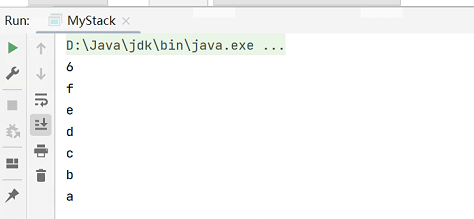
1.2.2 链表结构
链表结构是由许多节点构成,每个节点都包含两个部分:
数据部分:保存该节点的实际数据
地址部分:保存上一个或下一个节点的地址
链表的分类:单向链表、双向链表、双向循环链表
链表的特点:
结点在存储器中的位置是任意的,即逻辑上相邻的数据元素在物理上不一定相邻。
访问时只能通过头或者尾指针进 入链表,并通过每个结点的指针域向后或向前扫描其余结点,所以寻找第一个结点和最后-一个结点所花费的时间不等。
链表的优缺点:
优点::数据元素的个数可以自由扩充、插入、删除等操作不必移动数据,只需修
改链接指针,修改效率较高。
缺点::必须采用顺序存取,即存取数据元素时,只能按链表的顺序进行访问,访问节点效率较低。
单向链表:
单向链表是链表的一种,其特点是链表的链接方向是单向的,对链表的访问需要通过从头部开始顺序读取。
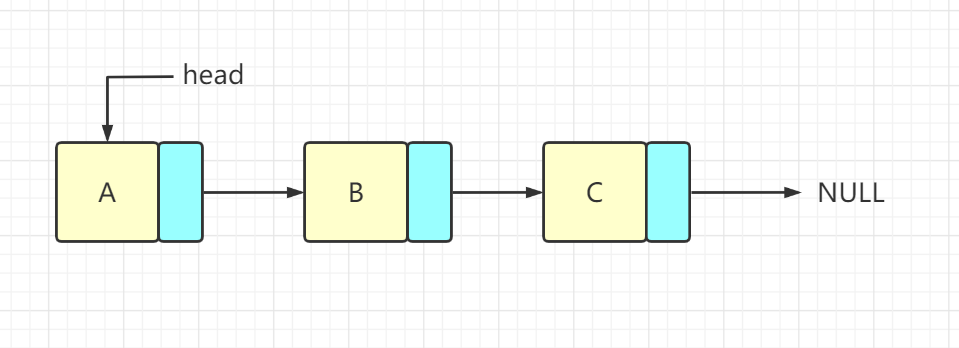 实现单向链表:
实现单向链表:
【示例】创建链表接口
/*
* 基于链表结构存取元素的方法API定义
* */
public interface MyList<E> {
void add(E element);
E get(int index);
int size();
E remove(int index);
}
【示例】创建单向链表类
/*
* 基于单向链表实现元素存取的容器
* */
public class MySinglyLinkedList<E> implements MyList<E>{
//向链表中添加元素
@Override
public void add(E element) {
}
//根据元素的位置获取元素
@Override
public E get(int index) {
return null;
}
//获取元素的个数
@Override
public int size() {
return 0;
}
//根据元素的位置删除元素
@Override
public E remove(int index) {
return null;
}
public static void main(String[] args) {
}
}
【示例】创建节点类
//定义单向链表中的节点对象
class Node<E>{
private E item; //存储元素
private Node next; //存储下一个节点对象的地址
Node(E item,Node next) {
this.item = item;
this.next = next;
}
}
【示例】实现添加元素方法
private Node head; //存放链表中的头节点
private int size; //记录元素个数
//向链表中添加元素
@Override
public void add(E element) {
//创建节点
Node<E> node = new Node<>(element,null);
//找到尾节点
Node tail = getTail();
//节点的挂接
if (tail == null){
this.head = node;
}else {
tail.next = node;
}
//记录元素个数
this.size++;
}
//找尾节点
private Node getTail(){
//判断头节点是否存在
if (this.head == null){
return null;
}
//查找尾节点
Node node = this.head;
while (true){
if (node.next == null) break;
node = node.next; //移动指针,指向下一个节点
}
return node;
}
【示例】实现获取元素方法
//根据元素的位置获取元素
@Override
public E get(int index) {
//校验index的合法性
this.checkIndex(index);
//根据位置获取指定节点
Node<E> node = this.getNode(index);
//将该节点中的元素返回
return node.item;
}
//对index进行校验
private void checkIndex(int index){
if (!(index >= 0 && index < this.size)){
throw new IndexOutOfBoundsException("Index:"+index+"Size:"+this.size);
}
}
//根据位置获取节点
private Node getNode(int index){
Node<E> node = this.head;
for (int i = 0; i < index; i++) {
node = node.next;
}
return node;
}
【示例】实现删除元素方法
//根据元素的位置删除元素
@Override
public E remove(int index) {
//校验index的合法性
this.checkIndex(index);
//根据位置找到该节点对象
Node<E> node = this.getNode(index);
//获取该节点对象中的元素
E item = node.item;
//将该节点对象从单向链表中移除
//判断当前删除的节点是否为头节点
if (this.head == node){
this.head = node.next;
}else {
//找到该节点的前一个节点
Node<E> temp = this.head;
for (int i = 0; i < index-1; i++) {
temp = temp.next;
}
temp.next = node.next;
}
node.next = null;
//记录元素个数
this.size--;
//将该元素返回
return item;
}
【示例】实现获取元素个数
//获取元素的个数
@Override
public int size() {
return this.size;
}
【示例】测试单向链表
public static void main(String[] args) {
MySinglyLinkedList<String> mySinglyLinkedList = new MySinglyLinkedList<>();
mySinglyLinkedList.add("a");
mySinglyLinkedList.add("b");
mySinglyLinkedList.add("c");
mySinglyLinkedList.add("d");
System.out.println(mySinglyLinkedList.size());
System.out.println(mySinglyLinkedList.remove(0));
for (int i = 0; i < mySinglyLinkedList.size(); i++) {
System.out.println(mySinglyLinkedList.get(i));
}
}
测试结果:
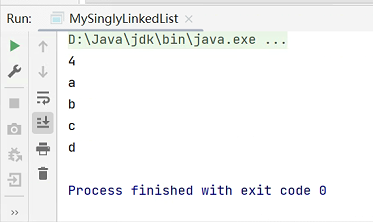
双向链表结构
双向链表是链表的一种,它的每个数据节点中都有两个指针,分别指向直接前驱和直接后继
 实现双向链表
实现双向链表
【示例】创建双向链表类
/*
* 基于双向链表实现元素存取的容器
* */
public class MyDoublyLinkedList<E> implements MyList<E>{
//向双向链表中添加元素的方法
@Override
public void add(E element) {
}
//根据指定位置获取元素
@Override
public E get(int index) {
return null;
}
//返回元素的个数
@Override
public int size() {
return 0;
}
//根据指定位置删除元素
@Override
public E remove(int index) {
return null;
}
public static void main(String[] args) {
}
}
【示例】创建节点类
//定义双向链表的节点对象
class Node<E>{
E item; //记录元素
Node<E> prev; //记录前一个节点对象
Node<E> next; //记录下一个节点对象
Node(Node<E> prev,E item,Node<E> next){
this.prev = prev;
this.item = item;
this.next = next;
}
}
【示例】实现添加元素方法
//向双向链表中添加元素的方法
@Override
public void add(E element) {
this.linkLast(element);
}
//将节点对象添加到双向链表的尾部
private void linkLast(E element){
//获取尾节点
Node t = this.tail;
//创建节点对象
Node<E> node = new Node<>(t,element,null);
//将新节点定义为尾节点
this.tail = node;
if (t == null){
this.head = node;
}else {
t.next = node;
}
this.size++;
}
【示例】实现获取元素方法
//根据指定位置获取元素
@Override
public E get(int index) {
//对index做合法性校验
this.checkIndex(index);
//根据位置查找节点对象
Node<E> node = this.getNode(index);
return node.item;
}
//校验index合法性
private void checkIndex(int index){
if (!(index >= 0 || index < this.size)){
throw new IndexOutOfBoundsException("Index:"+index+" Size:"+size);
}
}
//根据位置获取指定节点对象
private Node getNode(int index){
//判断当前位置距离头或者尾哪个节点更近
if (index <(this.size >> 1)){
Node node = this.head;
for (int i = 0; i < index; i++) {
node = node.next;
}
return node;
}else {
Node node = this.tail;
for (int i = this.size-1; i > index; i--) {
node = node.prev;
}
return node;
}
}
【示例】实现删除元素方法
//根据指定位置删除元素
@Override
public E remove(int index) {
//对index进行合法性校验
this.checkIndex(index);
//根据指定位置获取节点对象
Node<E> node = this.getNode(index);
//获取节点对象的元素
E item = node.item;
//判断当前节点是否为头节点
if (node.prev == null){
this.head = node.next;
}else{
//完成当前节点的直接前驱节点与当前节点的直接后继节点的挂接
node.prev.next = node.next;
}
//判断当前节点是否为尾节点
if (node.next == null){
this.tail = node.prev;
}else{
//完成当前节点的直接后继节点与当前节点的直接前驱节点的挂接
node.next.prev = node.prev;
}
//当前节点断掉与它直接前驱节点的连接
node.prev = null;
node.item = null;
//当前节点断掉与它直接后继节点的连接
node.next = null;
//记录元素个数
this.size--;
return item;
}
【示例】获取元素的个数
//返回元素的个数
@Override
public int size() {
return this.size;
}
【示例】测试
public static void main(String[] args) {
MyList<String> myList = new MyDoublyLinkedList<>();
myList.add("a");
myList.add("b");
myList.add("c");
myList.add("d");
System.out.println(myList.size());
System.out.println(myList.remove(2));
for (int i = 0; i < myList.size(); i++) {
System.out.println(myList.get(i));
}
}
【示例】实现在双向链表的头添加元素
//在双向链表的头添加元素
public void addFirst(E element){
this.linkFirst(element);
}
//在链表的头添加元素
private void linkFirst(E element){
//获取头节点对象
Node head = this.head;
Node node = new Node(null,element,head);
//将新节点定义为头节点
this.head = node;
//判断当前链表中是否有节点,如果没有那么该节点既是头节点也是尾节点
if(head == null){
this.tail = node;
}else{
head.prev = node;
}
//记录元素个数
this.size++;
}
【示例】实现在双向链表的尾添加元素
//在双向链表的尾添加元素
private void addLast(E element){
this.linkLast(element);
}
【示例】测试
MyDoublyLinkedList<String> list = new MyDoublyLinkedList<>();
list.add("a");
list.addFirst("A");
list.addLast("B");
list.addFirst("C");
for (int i = 0; i < list.size; i++) {
System.out.println(list.get(i));
}
测试结果:
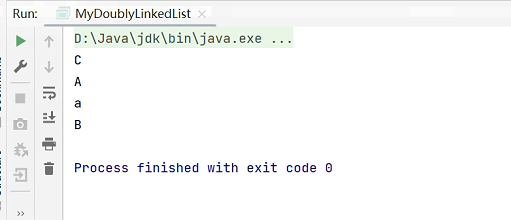
1.3 树形结构
树形结构是一种非线性存储结构,存储的是具有“一对多”关系的集合
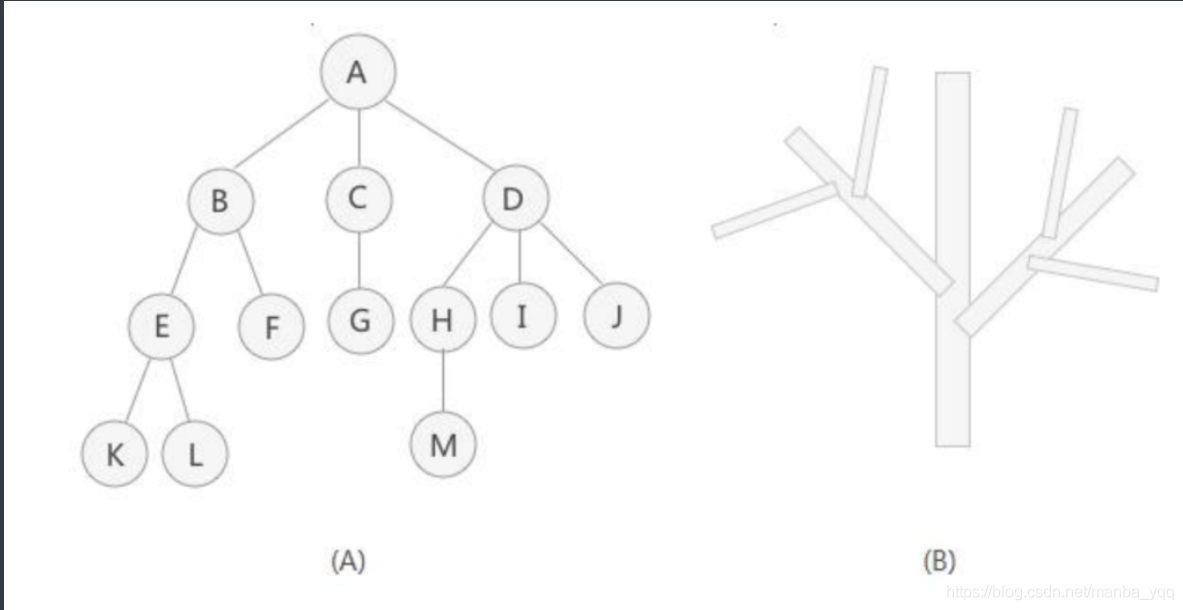
树的相关术语
结点(Node):使用树结构存储的每一个数据元素都被称为“结点”。
结点的度(Degree of Node):某个结点所拥有的子树的个数。
树的深度(Degree of Tree):树中结点的最大层次数。
叶子结点(Leaf Node):度为0的结点,也叫终端结点。
分支结点(Branch Node):度不为0的结点,也叫非终端结点或内部结点。
孩子(Child):也可称之为子树或者子结点,表示当前结点下层的直接结点。
双亲(Parent):也可称之为父结点,表示当前结点的直接上层结点。
根结点(Root Node):没有双亲结点的结点。在一个树形结构中只有一个根结点。
祖先(Ancestor):从当前结点上层的所有结点。
子孙(Descendant):当前结点下层的所有结点、
兄弟(Brother):同一双亲的孩子。
1.3.1 二叉树
二叉树(Binary Tree)是树形结构的一个重要类型。许多实际问题抽象出来的数据结构往往是二叉树形式,即使是一般的树也能简单地转换为 二叉树,而且二叉树的存储结构及其算法都较为简单,因此二叉树显得特别重要。二叉树特点是每个结点最多只能有两棵子树,且有左右之分。
满二叉树
满二叉树指除最后层外,每一层上的所有节点都有两个子节点。
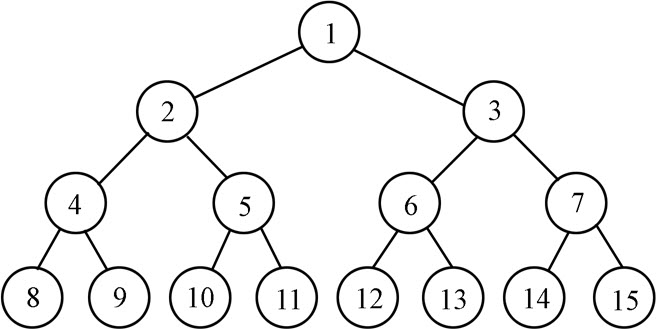
完全二叉树
完全二叉树除最后一层可能不满外,其他各层都达到该层的最大数,最后一层如果不满,该层所有节点都全部靠左排。
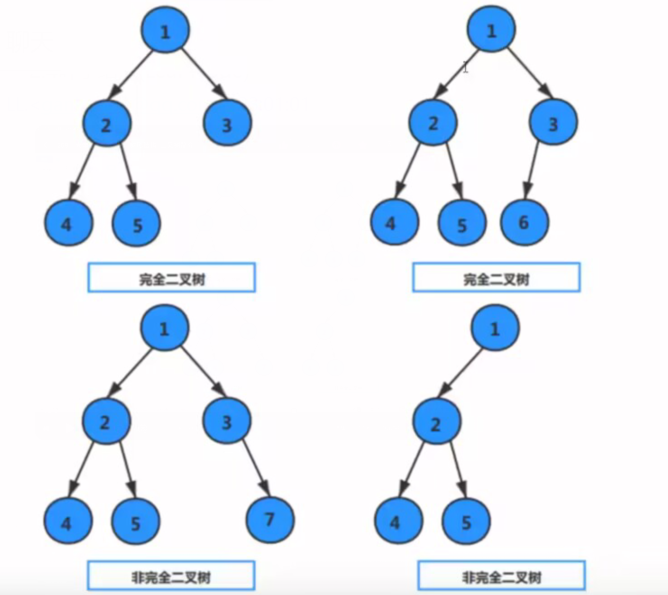
二叉树遍历:
前序遍历:根-左-右
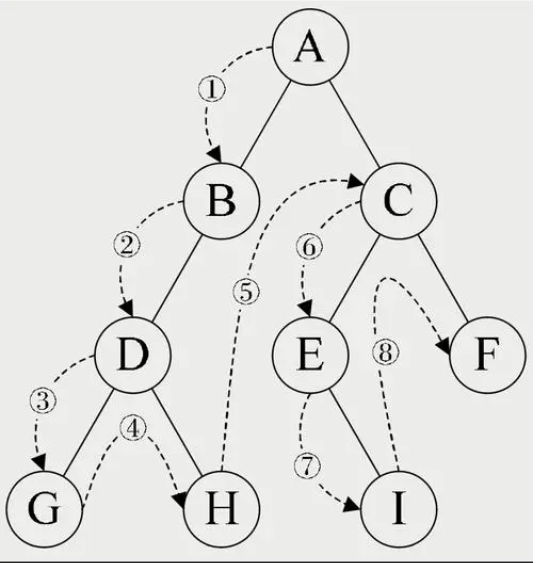
中序遍历:左-根-右

后序遍历:左-右-根
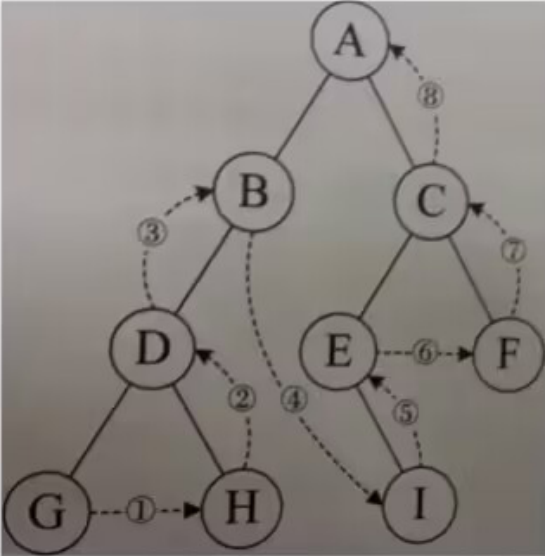
层序遍历:从上至下逐层遍历

【示例】创建二叉树排序类
/*
* 基于二叉树结构实现元素排序处理的排序器
* */
public class BinaryTreeSort<E extends Integer> {
//将元素添加到排序器中
public void add(E element){
}
//对元素进行排序
public void sort(){
}
public static void main(String[] args) {
}
}
【示例】创建结点类
//定义结点类
class Node<E extends Integer> {
private E item; //存放元素
private Node left; //存放左子树地址
private Node right; //存放右子树地址
Node(E item){
this.item = item;
}
//添加结点
public void addNode(Node node){
//完成新结点的元素与当前结点中的元素判断
//如果新结点中的元素小于当前节点中的元素,那么新节点则存放到当前结点的左子树中
if (node.item.intValue() < this.item.intValue()){
if (this.left == null)
this.left = node;
else
this.left.addNode(node);
}else{
//如果新结点中的元素大于当前节点中的元素,那么新节点则存放到当前结点的右子树中
if (this.right == null)
this.right = node;
else
this.right.addNode(node);
}
}
//使用中序遍历二叉树
public void inorderTraversal(){
//找到最左侧的那个结点
if (this.left != null){
this.left.inorderTraversal();
}
System.out.println(this.item);
if (this.right != null){
this.right.inorderTraversal();
}
}
}
【示例】实现向排序器中添加元素方法
private Node root; //存放树的根结点的地址
//将元素添加到排序器中
public void add(E element){
//实例化结点对象
Node<E> node = new Node<>(element);
//判断当前二叉树中是否有根结点,如果没有那么新节点则为根结点
if (this.root == null){
this.root = node;
}else{
this.root.addNode(node);
}
}
【示例】实现排序器中排序方法
//对元素进行排序
public void sort(){
//判断结点是否为空
if (this.root == null)return;
this.root.inorderTraversal();
}
【示例】测试
public static void main(String[] args) {
BinaryTreeSort<Integer> t = new BinaryTreeSort<>();
//1,8,6,3,5,2
t.add(1);
t.add(8);
t.add(6);
t.add(3);
t.add(5);
t.add(2);
t.sort();
}
测试结果:
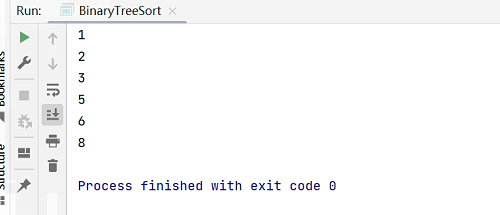
1.3.3 自定义树形结构容器
树形结构定义:
能够找到当前结点的父结点
能够找到当前结点的子结点
能够找到当前结点的兄弟结点
能够找到当前结点的祖先结点
能够找到当前结点的子孙节点
1.3.4 自定义树形结构分析
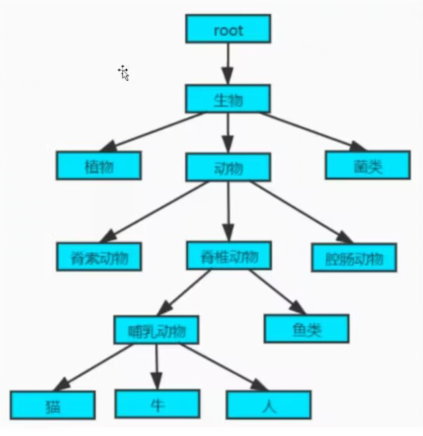
实现自定义树形结构容器
【示例】创建树形结构容器类
import java.util.List;
/*
* 基于树形结构实现元素存储的容器
* */
public class MyTree<E> {
/*向容器中添加元素*/
public void add(E parent,E item){
}
/*获取当前结点的父结点*/
public E getParent(E item){
return null;
}
/*获取当前结点的子节点*/
public List<E> getChild(E item){
return null;
}
/*获取当前结点兄弟结点*/
public List<E> getBrother(E item){
return null;
}
/*获取当前节点的祖先结点*/
public List<E> getForefather(E item){
return null;
}
/*获取当前结点的子孙结点*/
public List<E> getGrandChildren(E item){
return null;
}
public static void main(String[] args) {
}
}
【示例】实现添加元素方法
private Map<E,E> map = new HashMap<>(); //String-->String
private Map<E,List<E>> map2 = new HashMap<>(); //Sting-->List
/*向容器中添加元素*/
public void add(E parent,E item){
//先完成树中的单节点映射
this.map.put(item,parent);
//完成多结点之间映射
List<E> list = this.map2.get(parent);
//判断当前结点下是否含有子节点,如果没有则创建一个新的List
if (list == null){
list = new ArrayList<>();
this.map2.put(parent,list);
}
list.add(item);
}
【示例】获取父结点
/*获取当前结点的父结点*/
public E getParent(E item){
return this.map.get(item);
}
【示例】获取子结点
/*获取当前结点的子节点*/
public List<E> getChild(E item){
return this.map2.get(item);
}
【示例】获取当前结点的兄弟结点
/*获取当前结点兄弟结点*/
public List<E> getBrother(E item){
//获取当前结点的富姐但
E parent = this.getParent(item);
//获取当前父结点的所有子节点
List<E> list = this.getChild(parent);
List<E> brother = new ArrayList<>();
if (list != null){
brother.addAll(list);
brother.remove(item);
}
return brother;
}
【示例】获取当前结点的祖先结点
/*获取当前节点的祖先结点*/
public List<E> getForefather(E item){
//获取当前结点的父结点
E parent = this.getParent(item);
//结束递归的边界条件
if (parent == null){
return new ArrayList<>();
}
//递归调用,再次获取当前结点父结点的父结点
List<E> list = this.getForefather(parent);
//将递归到的所有结点元素添加到返回的List中
list.add(parent);
return list;
}
【示例】获取当前结点的子孙结点
/*获取当前结点的子孙结点*/
public List<E> getGrandChildren(E item){
//存放所有子孙结点中的元素
List<E> list = new ArrayList<>();
//获取当前结点的子节点
List<E> child = this.getChild(item);
//结束递归的边界条件
if (child == null){
return list;
}
//遍历子节点
for (int i = 0; i < child.size(); i++) {
//获取结点中的元素
E ele = child.get(i);
List<E> temp = this.getGrandChildren(ele);
list.add(ele);
list.addAll(temp);
}
return list;
}
【示例】测试
public static void main(String[] args) {
//实例化容器
MyTree<String> myTree = new MyTree<>();
//添加元素
myTree.add("root","生物");
myTree.add("生物","植物");
myTree.add("生物","动物");
myTree.add("生物","菌类");
myTree.add("动物","脊索动物");
myTree.add("动物","脊椎动物");
myTree.add("动物","腔肠动物");
myTree.add("脊椎动物","哺乳动物");
myTree.add("脊椎动物","鱼类");
myTree.add("哺乳动物","猫");
myTree.add("哺乳动物","牛");
myTree.add("哺乳动物","人");
System.out.println("=========获取父结点==========");
String parent = myTree.getParent("鱼类");
System.out.println(parent);
System.out.println("=========获取子结点==========");
List<String> child = myTree.getChild("动物");
for (String list:child) {
System.out.print(list+"\t");
}
System.out.println();
System.out.println("=========获取兄弟结点=========");
List<String> brother = myTree.getBrother("脊椎动物");
for (String list:brother) {
System.out.print(list+"\t");
}
System.out.println();
System.out.println("=========获取祖先结点=========");
List<String> foreFather = myTree.getForefather("人");
for (String list:foreFather) {
System.out.print(list+"\t");
}
System.out.println();
System.out.println("=========获取子孙结点=========");
List<String> grandChildren = myTree.getGrandChildren("root");
for (String list:grandChildren) {
System.out.print(list+"\t");
}
}
测试结果:
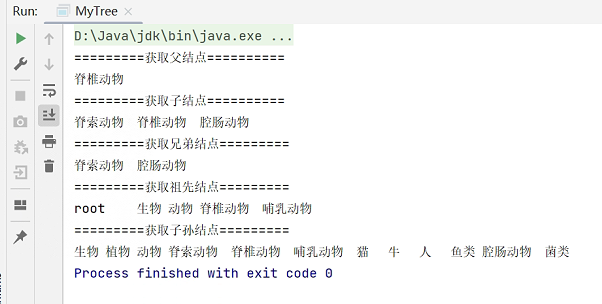





















 249
249











 被折叠的 条评论
为什么被折叠?
被折叠的 条评论
为什么被折叠?








